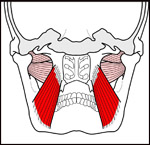This is a series on jaw pain and TMJ. If you missed the beginning, go back to Part 1.
Now that you know where the bones are and what they are called I’m going to use their anatomical names to help you find the muscles you will want to treat. If you didn’t read that part, go back to Self-Treatment: Finding the bony landmarks.
Neuromuscular Therapy Treatment protocol: When you’ve pressed hard enough to elicit a pain of 6 on a number scale of 1-10, hold the pressure for 8-12 seconds or until you feel the muscle softening or the pain lessening. If you don’t feel a change, hold for up to 20 seconds. If you still don’t feel a change, leave your fingers there and let up the pressure for several seconds then press in again. If it still doesn’t release, try a third time and go back to it later. The muscle may need time to gather the blood and nutrients it needs to let go. Also, to prevent soreness, just press. Grinding or deeply rubbing on tight muscles can irritate the tissue.
 Medial pterygoid: Find the angle of the jaw, where the ramus meets the body of the mandible. The medial pterygoid attaches to the inside of that bony angle both above it and forward of it. Tuck your thumb around the angle of bone and squeeze. You may find it difficult to go deeper if the muscles in the floor of the mouth are tight, so relax your tongue with your teeth closed when trying to access this muscle. When you can, push your thumb deeper into the angle and squeeze your thumb against the bone. You may feel tightening or pain up at the back of your mouth and tongue and deep in the ear as well as at the TM joint. Stuffiness in the ear can also result from TrPs here. Follow the treatment protocol above.
Medial pterygoid: Find the angle of the jaw, where the ramus meets the body of the mandible. The medial pterygoid attaches to the inside of that bony angle both above it and forward of it. Tuck your thumb around the angle of bone and squeeze. You may find it difficult to go deeper if the muscles in the floor of the mouth are tight, so relax your tongue with your teeth closed when trying to access this muscle. When you can, push your thumb deeper into the angle and squeeze your thumb against the bone. You may feel tightening or pain up at the back of your mouth and tongue and deep in the ear as well as at the TM joint. Stuffiness in the ear can also result from TrPs here. Follow the treatment protocol above.
 If you want to try to treat it internally: (The illustration shows the muscle from the inside of the jaw viewed from the back.) Use your right index finger for the right side of your jaw. Slide your finger between your teeth until it contacts the bone at the back. Slide your finger around it going further inside. The pad of your finger is on the medial pterygoid. Curl your fingertip against it to exhert pressure. To get the attachment at the angle of the mandible, slide your finger down across the bump in your gum where your teeth go below the gumline and go deep and back to the angle of your jaw. You can check your position with the fingers of your other hand under your jaw as you did treating it from the outside (see above). Press using the NMT protocol.
If you want to try to treat it internally: (The illustration shows the muscle from the inside of the jaw viewed from the back.) Use your right index finger for the right side of your jaw. Slide your finger between your teeth until it contacts the bone at the back. Slide your finger around it going further inside. The pad of your finger is on the medial pterygoid. Curl your fingertip against it to exhert pressure. To get the attachment at the angle of the mandible, slide your finger down across the bump in your gum where your teeth go below the gumline and go deep and back to the angle of your jaw. You can check your position with the fingers of your other hand under your jaw as you did treating it from the outside (see above). Press using the NMT protocol.
Good info on the medial muscles. I’ve had such problems with tightness which has now been relieved with physical therapy